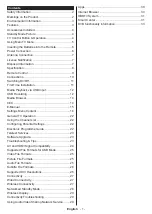
Service Modes, Error Codes, and Fault Finding
EN 21
FTL2.1, FTL2.2E AA
5.
8 V and 5 V protections:
The microprocessor senses the
presence of the 8 V and 5 V (via the “+5V_CON” and
“+8V_CON” lines). If one (or both) of these voltages is (are) not
present, an error code is stored in the error buffer of the NVM,
and the set is put in the protection mode.
Audio DC protection:
The OTC senses if the audio module is
in protection via IRQ-DIGITAL (pin 98 of OTC). If this is the
case, the OTC puts the set in protection.
5.7.4
Hardware Protection
Short-circuiting the 3V3 supply from the DC/DC converter will
shut down the DC/DC converter. The absence of the 3V3
supply line is also sensed via I
2
C (see description DC/DC
protection above), this is useful if there is something wrong in
the detection circuit of the DC/DC converter. There are no
hardware protections in this chassis, which switch off the main
supply.
5.8
Repair tips
5.8.1
3V3 Supply (DC/DC converter)
As mentioned above, the DC/DC converter is switched “off”
when something goes wrong (detection of a missing 3V3
supply at one of the devices supplied by the 3V3). Because of
this, the set goes to protection (I
2
C protection). Error code 55 is
logged.
For further diagnoses, you need to overrule the I
2
C protection:
put the set in Service Default Mode by means of the solder
pads on the SSB.
The DC/DC converter is still not working because it is switched
“off” by the 3V3_FAULT line (schematic B12). Now you have
some possibilities:
1.
First, measure the impedance over diode 6U06. In normal
conditions, you should measure approximately 120 ohm (if
possible, verify this with another set). If the impedance is
much too low, do not try to start up the converter as
mentioned below. Remind that if FET 7U03 is short-
circuited, this will also influence your measurement.
2.
Desolder coils 5U05 and 5U06, connect an external 3V3
supply at capacitor 2U23 (current limitation to 500 mA) and
a second external 3V3 supply at capacitor 2U31 (current
limitation to 800 mA). The normal working current of the
3V3_SIM line is approximately 400 mA and the normal
working current for the 3V3_DCDCFBX line is
approximately 700 mA. Therefore, if one of the currents
exceeds their nominal value you can determine in which
circuit the overload is situated. If the set would start up and
you have normal picture, there is probably no overload but
a problem in the detection circuits.
3.
If you do not have two external power supplies, you can do
the following: Desolder coils 5U02, 5U03, and 5U04 (you
must desolder all three, otherwise the circuit could be
damaged), connect an external power supply of 3V3 at the
cathode of diode 6U06. Make sure to limit the current of this
external supply to approximately 1200 mA. If the supplied
current exceeds 1100 mA (approximately normal working
current) you can conclude that one of the devices supplied
by 3V3 is short-circuited.
4.
Another possibility is to force the converter to start up by
short-circuiting (and keep short-circuited) resistor 3U25
(B12).
Caution
: Be aware that this can damage the set. Even if
you measure approximately 120 ohm over diode 6U06,
there can still be something wrong in the converter itself.
By short-circuiting resistor 3U25, the internal protection of
the converter is disabled.
5.8.2
ComPair
This chassis does not have an IR transmitting LED (as in MG-
sets). Therefore, a “Service” (ComPair) connector is
implemented at the rear side of the set, which is directly
accessible. In addition to this, there is also a blinking LED
procedure to show the contents of the error buffer.
When you use ComPair, you have the possibility to activate a
“stepwise start-up” mode. With this mode, you can initiate the
start-up sequence step by step. This also means that in certain
steps, some protections are not activated. This is sometimes
very convenient during repair.
5.8.3
Protections
Activating SDM via the “service pads” will overrule the
processor-controlled protections, but not the hardware
protections. This means, that the A/D-input protections (5 and
8 V) and the I
2
C “not-acknowledging” info of FBX + EPLD + 3D
Comb and of the tuner are overruled.
Caution
: When doing this, the service technician must know
what he is doing, as it could lead to damaging the set.
Содержание FTL2.1E
Страница 94: ...94 FTL2 xE AA 7 Circuit Diagrams and PWB Layouts Layout SSB Top Side Part 1 Part 1 E_14620_053a eps 040105 ...
Страница 96: ...96 FTL2 xE AA 7 Circuit Diagrams and PWB Layouts Layout SSB Top Side Part 3 E_14620_053c eps 040105 Part 3 ...
Страница 97: ...Circuit Diagrams and PWB Layouts 97 FTL2 xE AA 7 Layout SSB Top Side Part 4 Part 4 E_14620_053d eps 040105 ...
Страница 100: ...100 FTL2 xE AA 7 Circuit Diagrams and PWB Layouts Layout SSB Bottom Side Part 1 Part 1 SAM SDM E_14620_054a eps 300305 ...
Страница 101: ...Circuit Diagrams and PWB Layouts 101 FTL2 xE AA 7 Layout SSB Bottom Side Part 2 Part 2 E_14620_054b eps 300305 ...
Страница 102: ...102 FTL2 xE AA 7 Circuit Diagrams and PWB Layouts Layout SSB Bottom Side Part 3 Part 3 E_14620_054c eps 300305 ...
Страница 103: ...Circuit Diagrams and PWB Layouts 103 FTL2 xE AA 7 Layout SSB Bottom Side Part 4 Part 4 E_14620_054d eps 300305 ...
















































